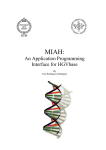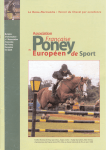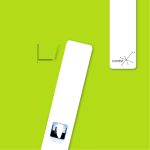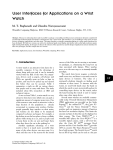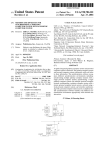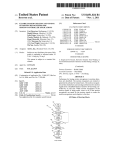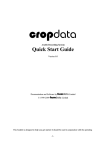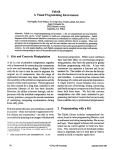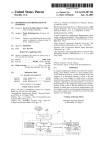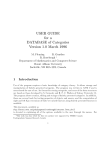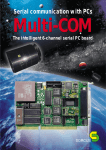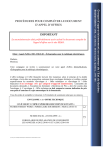Download Method and apparatus for remotely accessing files from a desktop
Transcript
US005845282A
United States Patent [19]
[11]
Patent Number:
Alley et al.
[45]
Date of Patent:
[54]
METHOD AND APPARATUS FOR
REMOTELY ACCESSING FILES FROM A
DESKTOP COMPUTER USING A PERSONAL
DIGITAL ASSISTANT
5,519,851
5/1996
5,561,446
10/1996
5,845,282
*Dec. 1, 1998
Bender et a1. ........................ .. 395/500
Montlick
........
. . . ..
5,577,177 11/1996 Collins et a1.
5,579,481
5,583,978
5,592,657
5,630,168
[75] Inventors: Peter E. Alley, Saratoga; Joseph G.
Ansanelli, Palo Alto, both of Calif.
345/173
395/169
11/1996 Drerup ......... ..
395/20001
12/1996 Collins et a1. ........................ .. 395/170
1/1997 Johnson et a1. ....................... .. 395/200
5/1997 Rosebrugh et a1. .................. .. 395/825
OTHER PUBLICATIONS
[73] Assignee: Apple Computer, Inc., Cupertino,
Calif.
[*]
Notice:
This patent issued on a continued pros
ecution application ?led under 37 CFR
1.53(d), and is subject to the twenty year
patent term provisions of 35 U.S.C.
154(a)(2).
[21] Appl. No.: 511,978
[22] Filed:
Aug. 7, 1995
Schilit et al, The PARCTAB Mobile Computing System,
IEEE, pp. 34—39, Oct. 1993.
Christopher et a1, Overview of Nine Evaluations of Pen
Based Computers, PC Magazine, v12, n17, printed pp.
16—29, Oct. 1993.
John RiZZo, Windows in a Mac World, Mar. 1993, MacUser.
Farallon, “Connect Your PC to a Macintosh Network,” 1993,
Product Literature for Timbuktu for Windows.
Farallon, “Remote Control and File Transfer for Networks,”
1993, Product Literature for Timbuktu Pro for Macintosh.
Farallon, “Your AppleTalk Connect for DOS and Windows,”
1992—1994, Product Literature for PhoneNET PC 3.1.
[51]
Int. Cl.6 .................................................... .. G06F 17/30
Farallon, User’s Manual to Timbuktu Remote, 1991, Chap
[52]
[58]
US. Cl. ...................... .. 707/10; 707/104; 395/200.62
Field of Search ............................. .. 395/200.03, 650,
ter 5, pp. 63—74.
395/200, 500, 169, 170, 400, 601, 616,
610, 615, 604, 200.01, 825, 200.62; 382/69;
364/200, 708; 345/173; 178/19; 380/25;
707/10, 104
[56]
References Cited
3/1987
4,686,332
8/1987 Greanias et a1. .
4,774,655
9/1988 Kollin et a1.
5,007,085
4/1991 Greanias et a1. .
380/25
5,175,854 12/1992 Cheung et a1. ..
395/650
Ouimette ................................. .. 382/69
178/19
364/200
5,224,060
6/1993
5,309,564
5/1994 Bradley et a1. ....................... .. 395/200
5,313,578
5/1994
5,329,619
7/1994 Page et a1.
5,471,615
166
ABSTRACT
puter data ?les from a remote computer includes an auto
4,653,112
Ma ........................................ .. 364/708
5,471,318 11/1995 Ahuja e161. ..
[57]
A method and apparatus for selecting and retrieving com
U.S. PATENT DOCUMENTS
Handorf ..... ..
Primary Examiner—Paul R. LintZ
Assistant Examiner—FrantZ Coby
Attorney, Agent, or Firm—Beyer & Weaver, LLP
395/200
395/200
matic ?le translation mechanism. In one embodiment, the
data being retrieved and the ?le translation mechanism are
located on the same computer. The method of the invention
includes establishing a data transfer link with the remote
computer, displaying the ?les available for retrieval from the
remote computer, selecting a ?le to be transferred, and
translating the ?le prior to transfer. In one embodiment, the
apparatus includes a pen-based computer and the remote
computer is a desktop computer.
358/400
11/1995 Amatsu et a1. .................. .. 395/200.03
19 Claims, 12 Drawing Sheets
U.S. Patent
Dec. 1,1998
Sheet 2 0f 12
5,845,282
U.S. Patent
Dec. 1,1998
Sheet 3 0f 12
5,845,282
W/134
If
152"
.
_
154:''''''’
\I:
_
________ "K: ____ ___
i _ _ _ _ _ __-[§XL
_ - - - - - - - -
/¢/‘
151
158~~
118*/__
/Z
_
'-
144
-------------------------- —-
_ _ _ _ _ _ _ _ _ _
_
_ _ _ _ _ _
_
_
_ _
;
_ “<'\\
_'-\_,120
_
------------ "X""' \--——-156
____ '_1'6_2_________________ "
<|~
I
:
\‘\-160
®§§®®
Names Dates Extras ‘ Undo Flnd Assist- :
—
1;] \
A
\
\.
\
126
22
k
K
A ‘I
(142
//
U.S. Patent
Dec. 1,1998
Sheet 4 0f 12
5,845,282
230Ew
U.S. Patent
Dec. 1,1998
Sheet 5 0f 12
5,845,282
182
180
/
Establish
Connection
Select
File '
r190
Figure 5
Perform
Function On
Selected File
194
No
Yes a
192
U.S. Patent
Dec. 1,1998
Sheet 6 0f 12
5,845,282
200
202
START
184
r204
Pass
Protocols
|___
|
Display
I
| User Options
|
208
Figure 6
U.S. Patent
Dec. 1, 1998
Sheet 8 0f 12
5,845,282
240
242
{244
Get Current
Directory Path
l r246
Get Directory
Contents
l K- 248
Display
Directory
Contents
250
Figure 8
U.S. Patent
Dec. 1, 1998
Sheet 9 0f 12
5,845,282
260
262
Yes
264
User
Selection
Action?
No
272
Yes
No
266
268
Yes
Action On
Selected File?
Yes
No
278
270
Folder
Selected?
Yes
\
Send Name
of Selected
Folder to
-
Desktop
No
274
No
276 \
Yes
Figure 9A
>
Implement
Action
<"_—‘
U.S. Patent
Dec. 1,1998
Sheet 10 0f 12
r 280
Send
“Get Info”
Command to
Desktop
K- 282
Display
<______
File Info
File
Closed?
284
Figure 9B
5,845,282
U.S. Patent
Dec. 1,1998
Sheet 11 0f 12
5,845,282
com
2m.
9;55mmmu“On2io-:z5
:mn3Eau2ms.-ums; \a:m.fmv
Em.
m22:5
00m.
EuONU-O.Z5
<293%
5,845,282
1
2
METHOD AND APPARATUS FOR
REMOTELY ACCESSING FILES FROM A
DESKTOP COMPUTER USING A PERSONAL
DIGITAL ASSISTANT
HoWever, the practical utility of both pen-based and
personal organiZer devices has been limited by their inability
to communicate efficiently With other computers, especially
desktop computers, Which hold information and softWare
BACKGROUND OF THE INVENTION
that Would be useful if available on the pen-based or
personal organiZer device at a remote location. Such infor
The present invention relates generally to computer sys
tems and to communication betWeen desktop and pen-based
information manager (“PIM”) data, in addition to informa
mation might include, for example, calendar and personal
computer systems. More particularly, the present invention
provides a method and apparatus for transferring and trans
lating ?les from a desktop computer to a remote pen-based
10
by the inability to provide a simple, remote connection
betWeen the desktop and pen-based computer in addition to
portable computer system.
Computers are becoming increasingly poWerful,
the cumbersome interface softWare necessary for transfer
lightWeight, and portable. The computing poWer of comput
ers that once ?lled entire rooms is noW residing on a desktop. 15
Laptop, notebook, and sub-notebook computers are virtually
as poWerful as their desktop counterparts. Even smaller
hand-held computers are noW capable of computing tasks
that required much larger machines a feW short years ago.
The present invention alleviates the above-described limi
tations of pen-based computers by providing facility for
broWsing and selecting ?les stored on a remote desktop
computer from a pen-based computer in an intuitive and
ef?cient manner. The present invention further provides for
small, lightWeight, relatively inexpensive, and can perform
the transfer and optional translation of the selected ?les,
25
provided in conventional computer systems, personal orga
users of these computers greater and more simpli?ed access
to the information stored on less mobile desktop systems.
In one aspect, the present invention provides a method for
are available from many companies including Sharp and
Casio of Japan.
transferring data from a ?rst computer system running a
server program under a ?rst operating system to a second
computer system running a control program under a second
35
The second computer system then displays a list of ?les
is provided With a dual-function display assembly that can
serve as both an input device and an output device. When
45
bly senses the position of the tip of a stylus on the vieWing
screen and provides this positional information to the com
available on the ?rst computer system Which are available
for translation and transfer. A ?le on the ?rst computer
system is then selected for transfer. The ?le is then translated
and transferred to the second computer system.
In one embodiment, the eXchange of information and
commands is performed using a data structure comprising a
header, a command block, a length block and a data block.
The header comprises tWo blocks, the ?rst block holding
information effective to identify the second computer system
puter’s central processing unit (CPU). Some display assem
blies can also sense the pressure of the stylus on the screen
and the second block containing information effective to
to provide further information to the CPU. When operating
as an output device, the display assembly presents computer
generated images on the screen.
The dual-function display assemblies of pen-based com
identify a communications program on the second computer
system that is transferring data With the ?rst computer
system over the data link. The command block and the
length block each have a length of four-bytes and the length
puter systems permit users to operate the computer as a
computeriZed notepad, among other functions. For eXample,
graphical images can be input into the pen-based computer
operating system, the ?rst and second computer systems
being in communication through a communications
medium. In one embodiment, a data transfer link from the
control program on the second computer system to the
server program on the ?rst computer system is established.
120 pen-based computer made and marketed by Apple
Computer, Inc. of Cupertino, Calif.
Apen-based computer system is typically a small, hand
held computer Where the primary method for inputting data
includes a “pen” or stylus. Apen-based computer system is
commonly housed in a generally rectangular enclosure, and
operating as an input device or “tablet”, the display assem
again in a manner that is both intuitive and ef?cient. Thus,
it Will be seen that the present invention addresses tWo major
short comings of present pen-based computers by providing
niZers are very Well suited to the personal organiZation task
due to their small siZe and portability. Personal organiZers
A relatively neW form of computer, the pen-based com
puter system, holds forth the promise of a marriage of the
poWer of a general purpose desktop computer With the
functionality and small siZe of a personal organiZer. An
eXample of a pen-based computer system is the Newton@
ring and translating ?les betWeen desktop and pen-based
computers.
SUMMARY OF THE INVENTION
As a part of this trend, computeriZed personal organiZers
are becoming increasingly popular With a large segment of
the population. ComputeriZed personal organiZers tend to be
such functions as keeping a calendar, an address book, a
to-do list, etc. While many of these functions can also be
tion contained in ?les such as Word processor documents.
The eXchange of such data and softWare betWeen a pen
based computer and a desktop computer has been hindered
55
of the data block is an even multiple of four.
In a second aspect, the present invention provides a
generates a corresponding image on the screen to create the
computer readable medium comprising program instructions
for performing the above-described steps of establishing a
data link betWeen the ?rst and second computer systems,
illusion that the stylus is draWing the image directly upon the
displaying a list of available ?les on the second computer,
screen, i.e., that the stylus is “inking” an image on the
selecting a ?le for transfer, and translating the selected ?le
screen. By “ink” it is meant that piXels on the screen are
activated in such a manner that it appears that the stylus is
on the ?rst computer system.
In a third aspect, the present invention provides an appa
ratus for selecting and receiving data stored on a remote
by merely moving the stylus on the surface of the screen. As
the CPU senses the position and movement of the stylus, it
leaving a trail of ink on the display assembly. With suitable
recognition softWare, the “ink” can be recogniZed to input
teXt, numerics, graphics, and other recogniZed information
into the pen-based system.
65
computer system. The apparatus of the invention comprises,
in one embodiment, means for establishing a data transfer
link With the remote computer system. The means for
5,845,282
3
4
establishing a data link are coupled to a remote ?le browser
that receives ?le information for data stored on the remote
computer system and displays the ?le information to a user
principally for reasons of common usage, to refer to these
of the apparatus. The ?le broWser is coupled to a ?le selector
that all of these and similar terms are to be associated With
that alloWs the user to identify at least one ?le to be
transferred from the remote computer system to the com
the appropriate physical quantities and are merely conve
nient labels applied to these quantities.
Further, the manipulations performed are often referred to
signals as bits, values, elements, variables, characters, data
structures, or the like. It should be remembered, hoWever,
puter apparatus. A translator that determines Whether the
selected ?le is to be translated in conjunction With the
transfer of the ?le to the computer apparatus is coupled to
the selector.
These and other advantages of the present invention Will
in terms, such as identifying, running, or comparing. In any
of the operations described herein that form part of the
present invention, these operations are machine operations.
Useful machines for performing the operations of the
present invention include general purpose digital computers
become apparent upon reading the folloWing detailed
descriptions and studying the various ?gures of the draW
or other similar devices. In all cases, there should be borne
ings.
15
BRIEF DESCRIPTION OF THE DRAWINGS
FIG. 1 is a block diagram of the electronics of a pen-based
to generate other desired physical signals.
computer system in accordance With the present invention.
FIG. 2 is a perspective vieW of a complete pen-based
The present invention also relates to an apparatus for
performing these operations. This apparatus may be spe
computer system including a housing, display assembly, and
cially constructed for the required purposes, or it may be a
stylus, Where the electronics of FIG. 1 are enclosed Within
general purpose computer selectively activated or recon?g
the housing.
ured by a computer program stored in the computer. The
processes presented herein are not inherently related to any
FIG. 3 is a top plan vieW of the housing and display
assembly of pen-based computer system of FIG. 2.
in mind the distinction betWeen the method of operations in
operating a computer and the method of computation itself.
The present invention relates to method steps for operating
a computer in processing electrical or other physical signals
25
FIG. 4 is a schematic illustration of a communications
link betWeen a remote pen-based computer and a desktop
computer.
particular computer or other apparatus. In particular, various
general purpose machines may be used With programs
Written in accordance With the teachings herein, or it may be
more convenient to construct a more specialiZed apparatus
to perform the required method steps. The required structure
FIG. 5 is a computer How diagram of an embodiment of
for a variety of these machines Will appear from the descrip
the method of the present invention.
FIG. 6 is a computer How diagram illustrating step 184 of
FIG. 5 in greater detail.
tion given beloW.
FIG. 7 is a schematic illustration of a data structure in
accordance With the present invention.
FIG. 8 is a computer How diagram further illustrating step
186 of FIG. 5.
FIGS. 9A and 9B are computer How diagrams illustrating
step 188 of FIG. 5 in greater detail.
FIGS. 10A—10D illustrate an interface implementing the
35
memory system 14, an input/output (I/O) dual function
display system 16, a clock system 18, a poWer system 20, a
sound system 22, a PCMCIA connector 24, and a serial I/O
system 26. The various components and systems of the
computer 10 are coupled together by an I/O controller 28
Which serves as an interface betWeen the CPU 12 and other
method of one embodiment of the present invention. FIG.
10A is an illustration demonstrating the interface With
regards to forming a connection betWeen a pen-based com
puter and a desktop computer. FIG. 10B illustrates the
display of directories and ?les folloWing the formation of a
As shoWn in FIG. 1, a block diagram 10 of the electronics
of a pen-based computer in accordance With the present
invention includes a central processing unit (CPU) 12, a
components of the computer 10. More speci?cally, the I/O
controller 28 is an application-speci?c integrated circuit
(ASIC) designed to handle memory, peripherals, and I/O
45
connection betWeen a pen based computer and a desktop
computer. FIG. 10C illustrates the selection of a ?le on the
remote desktop computer. FIG. 10D is an illustration shoW
tasks, as Well as housekeeping functions such as providing
system clocks, controlling poWer usage, etc. The design,
manufacture, and use of ASICs is Well knoWn to those
skilled in the art. The pen-based computer 10 as illustrated
is currently being manufactured and sold by Apple
ing the display of ?le information for the selected ?le shoWn
Computer, Inc. of Cupertino, Calif. as a NeWton® 120
in FIG. 10C.
Personal Digital Assistant (PDA).
CPU 12 is preferably a commercially available, single
DETAILED DESCRIPTION OF THE
PREFERRED EMBODIMENTS
The present invention is Well suited for pointer- or pen
based computer systems such as the pen-based, pen-aWare,
mouse, track ball, and track pad controlled systems that are
chip microprocessor. While CPU 12 can be a complex
instruction set computer (CISC) chip, it is preferable that
55
be of generally higher performance than CISC chips. In the
present embodiment, the CPU 12 is preferably an ARM®
610 RISC chip operating at 20 megahertZ and is available
from a variety of sources including VLSI Technology, Inc.
of San Jose, Calif. and Plessey Semiconductor of England.
The present CPU 12 includes a 32 bit data (D) bus 30, a 32
bit address (A) bus 32, and an 8 bit control (C) bus 34.
currently popular. For the purposes of illustration, the inven
tion Will be described in connection With a pen-based
system.
It Will be appreciated that the invention employs various
process steps involving data stored in computer systems.
These steps are those requiring physical manipulation of
physical quantities. Usually, though not necessarily, these
quantities take the form of electrical or magnetic signals
CPU 12 be one of the commercially available, reduced
instruction set computer (RISC) chips Which are knoWn to
The memory system 14 includes static random access
capable of being stored, transferred, combined, compared,
memory (SRAM) 36, non-volatile read/Write “?ash”
memory 38, and read-only memory (ROM) 40. The SRAM
and otherWise manipulated. It is sometimes convenient,
36 serves as volatile “scratch pad” memory for the computer
65
5,845,282
5
6
system 10 and, in the current system, includes 512 kilobytes
of seconds that has elapsed since midnight, Jan. 1, 1904 (an
of memory. The ?ash memory 38 is Where user data is
arbitrary start time). The value in the RTC counter can be
stored, preferably includes about 2 megabytes of memory,
converted into time of day and date information by relatively
and is available as a standard product from Intel Corporation
of Santa Clara, Calif. The ROM 40 stores the operating
straight-forWard calculations Well knoWn to those skilled in
the art. Since the RTC crystal 68 is coupled to the controller
28 by a dedicated tWo-line bus 72 to provide the 32.768
kilohertZ signal to the controller 28.
The poWer system 20 provides poWer to the computer 10
and is coupled to the controller 28 by a dedicated
bi-directional bus 74. The bus 74 alloWs for the handling of
system and embedded application programs, and currently
comprises approximately 8 megabytes of memory. Of
course, there are many equivalents for the SRAM 36, ?ash
memory 38, and ROM 40. For example, dynamic random
access memory (DRAM) can be substituted for SRAM 36,
battery-backed random accessed memory (RAM) can be
substituted for ?ash memory 38, and a programmable read
only memory (PROM) can be substituted for the ROM 40.
The memory system 14 is coupled directly to the data (D)
bus 30 and the address (A) bus 32. The memory system 14
10
fault detection signals (e.g., loW poWer), sWitching on and
off poWer to the PCMCIA connector, etc. The poWer system
20 preferably controls the poWer system 20 to conserve
poWer at times of loW usage of the pen-based computer
15
is also coupled to a memory control bus 42 of controller 28.
The CPU 12 and controller 28 cooperate to read and Write
system.
The sound system 22 includes a small (18 mm diameter)
loudspeaker 76 and a D/A converter 78. The D/A converter
78 is coupled to the controller 28 by a line 80, and to the
data to the memory system 14 via the busses 30, 32, and 42.
loudspeaker 76 by a line 82. In the present embodiment, the
D/A converter 78 is a simple operational ampli?er (OP
AMP) Which acts as an integrator to integrate pulse Width
modulation (PWM) signals developed on line 80 to provide
an analog signal on line 82 to drive loudspeaker 76. Of
The display system 16 serves as both an input device and
an output device. More particularly, a tablet 44, multiplexer
(MUX) 46, and analog-to-digital
converter 48 convert
the contact of a stylus (see FIG. 2) With the tablet 44 and its
subsequent movement over the tablet into digital data that is
input to the controller 28. The tablet 44 is preferably a
four-Wire resistive membrane tablet and provides positional
course, more complex D/A converters can also be used to
provide higher quality sound output from loudspeaker 76, as
Will be apparent to those skilled in the art. Suitable OP
information on a bus 50 Which is input into the MUX 46.
The MUX 46 determines Which of the four sides of the tablet
is to be read. Such tablets are Widely available from a variety
AMPS to be used as a D/A converter 78 are readily available
of sources including Nissha of Japan. An output from the
on the commercial market, and the miniature loudspeaker is
also readily available, such as from Hosiden of Osaka,
MUX 46 is input to A/D converter 48 on a bus 52. An output
Japan.
from the A/D converter 48 is input into the controller 28.
The display system 16 further includes an ASIC 56, a
The PCMCIA connector 24 is coupled to the controller 28
dedicated SRAM 58, and an LCD screen 60. The ASIC 56
is an LCD controller coupled to the data (D) bus 30, the
address (A) bus 32, and the memory control bus 42. The
35
purpose of the ASIC 56 is to alloW the CPU 12 to Write to
dedicated bus 64. The ASIC 56 serves as a controller for the
screen 60, and uses the SRAM 58 as a frame buffer to store
images to be displayed on the screen 60. The LCD screen 60
is preferably a standard super-tWist LCD matrix screen
available from a number of sources including Seiko-Epson
of Japan. The LCD screen preferably comprises a rectan
gular array of picture elements or “pixels”, as is Well knoWn
to those skilled in the art.
The clock system 18 includes a main system clock 66 and
a real-time clock (RTC) crystal 68. The main system clock
40
The serial I/O system 26 includes a Serial Communica
45
50
clocks such as clock 66 can be commercially obtained from
55
60
continuous, precise, uninterrupted signal at 1 hertZ by divid
(also a part of the controller 28) to count of the total number
since at least the early 1980’s and supports a number of
serial protocols. The IR transceiver 92 is coupled to the SCC
90 by a line 102 for received IR signals, and to the controller
28 for IR signals to be transmitted. The IR transceiver
includes an IR transmitter (coupled to line 104) and an IR
receiver (coupled to line 102), and is available under license
from Sharp Corporation of Japan. The IR receiver includes
a PIN-type IR-sensitive diode having an output coupled to
an analog demodulator and an ampli?er to create a signal on
the basis of a crystal based oscillator that can provide a
ment. The one hertZ RTC signal increments a RTC counter
controller 28 by a bus 100. A suitable SCC 90 can be
purchased from Zilog Corporation of San Jose, Calif. as part
number Z85C30. The Zilog Z85C30 has been available
clock for the computer 10. In the present embodiment, the
main system clock 66 operates at 40 megahertZ. Oscillator
ing doWn the 32.768 kilohertZ crystal signal With a 10 bit
divider. The circuitry for performing this type of task is
Well-knoWn, and form a part of controller 28 in this embodi
pager cards, to name a feW.
tions Controller (SCC) 90, an infrared (IR) transceiver 92, a
serial port 94, and a line driver (LD) 96. The SCC 90 is
coupled to the data bus (D) 30 by a bus 98 and to the
is a four-terminal oscillator and is used to provide the master
many sources including Seiko-Epson of Japan. This master
clock may be divided doWn by the controller 28 for various
timing purposes in the system, and is coupled to the con
troller 28 by a line 70.
The RTC crystal 68 is tuned to 32.768 kilohertZ, Which is
evenly divisible by a poWer of 2. The RTC crystal 68 forms
control busses are industry standard and highly available as
the “PC Card” or “PCMCIA” standard. Avariety of devices
can ?t in the PCMCIA slot 24, including memory expansion
cards, miniature hard disk drive cards, modem cards, and
the screen as if it Were a RAM sitting on the memory bus 42.
The SRAM 58 is coupled to the ASIC 56 by a dedicated bus
62, and the screen 60 is coupled to the ASIC 56 by a
by a dedicated data (D‘) bus 84, a dedicated address (A‘) bus
86, and a dedicated control (C‘) bus 88. The PCMCIA
speci?cations for signals on the dedicated data, address, and
65
line 102, an IR LED coupled to line 104 to be directly driven
by a high-poWer sWitch of controller 28. The serial port 94
is a standard DIN 8 (8 pin) connector, and is coupled to the
line driver LD 96 by an eight bit bus 106. The LD 96 is
coupled to the SCC 90 by a bus 107.
Referring noW to FIG. 2, a pen based computer system
106 in accordance With the present invention includes the
computer 108 and a pen or stylus 110. The computer 108 is
enclosed Within a generally ?at, rectangular case 112 having
a front end 114, a back end 116, a left side 118, a right side
120, a top 122, and a bottom 124. The LCD 60 is positioned
5,845,282
7
8
along the top 122 of the case 112, and the clear membrane
tablet 44 is positioned over the LCD 60. Also positioned
beneath the tablet 44 along a loWer edge 126 thereof, is a
printed strip of material 128 including a number of indicia
130. When the tip 132 of the stylus 110 is engaged With the
The CPU 12 next produces data Which is transferred to the
screen 60 via ASIC 56 to produce appropriate images on the
membrane 44 over one of the indicia 130, the computer 108
152 and a number of guidelines 154. The header bar 152
preferably includes the date of creation of the note area 151
and a number of icons and “soft” buttons, not particularly
germane to the discussion of the present invention. The
guidelines 154 aid a user in entering text, graphics, and data
screen.
Upon poWer-up, pen based computer system 106 displays
on screen 60 an initial “note” area 151 including a header bar
can respond to the contact as if the indicia Were a “button.”
Therefore, as used herein, a “button” can be an image seen
through the tablet 44 (either from the screen 60 or from
printed material 128 or the like) that can serve the function
of an electro-mechanical button or the like When the tablet
44 is activated over a button image.
Alid 134 is connected to the back end 116 of case 112 by
hinge 136. When open as shoWn or folded back to contact
the bottom 124 of case 112, the tablet 44 and screen 60 are
available for use. When the cover 134 is folded over the top
122 of case 112, it fully covers the tablet 44 to protect the
delicate membrane material. The lid 134 is provided With a
latch member 138 Which engages a latch member 140 When
into the pen-based computer system 106. A text object T of
the text “Text Object” and a graphic object G of a triangle
are shoWn as being entered Within note area 151.
Additional note areas, such as a second note area 156, can
15
be formed by the user by draWing a substantially horiZontal
line across the tablet 44 With the stylus 110. The substan
tially horiZontal line is recogniZed by the computer system
106 and is converted into a second header bar 158. Addi
tional text, graphical, and other data can then be entered into
it is overlying the top 122 of the computer. The latch
member 138 is disengaged from the latch member 140 by a
this second note area 156.
The screen illustrated in FIG. 3 is referred to as the
mechanical latch release 142.
“notepad”, and is preferably an application program running
under the operating system of the pen based computer
system 10. In this preferred embodiment, the notepad is a
special or “base” application Which is usually or normally
Also seen in FIG. 2 is an “on” sWitch 144, a contrast
adjustment 146, and a grille 148 for the speaker 76. The
stylus 110 is of a collapsible design and can ?t into an
opening 150 along the right side 120 of case 112. Not seen
in this ?gure along the right side 120 of the case 112 is an
opening for a PCMCIA card Which can engage PCMCIA
25
available beneath higher level applications. The notepad
application, like other applications, run Within a WindoW,
Which in this instance comprises the entire screen 60.
connector 24, the DIN 8 port 94, and a poWer input jack. Not
Therefore, as used herein, a “Window” is the entire screen or
any portion of an entire screen Which is dedicated to a
seen along the bottom 124 of the case 112 is a battery access
cover and a mechanical ejection button for a PCMCIA card
particular application program. A description of the opera
engaged With the PCMCIA connector 24. The IR port 92 is
tion and use of the notepad can be found in US. Pat. No.
provided along back 116 of the case 112 and is exposed for
5,398,310, assigned to the assignee of the present invention,
and incorporated herein by reference.
use When the cover 134 is folded against the bottom 124 of
the case 112. The remaining components and systems of the
computer block diagram 10 of FIG. 1 are enclosed Within the
case 112 of the computer system 108.
It should be noted that the preceding discussion is of a
35
active areas and a number of display areas, Which again are
not particularly germane to the present invention and Will
therefore not be discussed in detail herein.
The term “object” Will be used extensively in the folloW
ing discussions. As is Well knoWn to softWare developers, an
preferred embodiment of the present invention, and that
there are many alternatives for the stylus 110. For example,
a ?ngernail or other pointed object could be used With the
tablet 44 of the present invention. Also, there are other types
of tablets available that utiliZe other types of styluses.
Other types of pointing devices can also be used in
conjunction With the present invention. While the method of
A status bar 160 is provided at the bottom of the notepad
application. The status bar 160 is provided With a number of
“object” is a logical softWare unit comprising data and
processes Which give it capabilities and attributes. For
45
example, an object can be queried as to its type and can
return such data as the number of Words that it contains,
What its bounding box (BBOX) is, etc. Objects can contain
the present invention is described in the context of a pen
based system, other pointing devices such as a computer
other objects of the same or of a different type. Objects can
also be used to project images on a screen according to their
mouse, a track ball, a track pad, a tablet, etc. can be used to
manipulate a pointer on a screen of a general purpose
object type. Example of object types used in the folloWing
description include paragraph, line, and Word objects. There
computer. Therefore, as used herein, the terms “pointer”,
“pointing device”, “pointing apparatus”, “pointing means”,
are many Well knoWn texts Which describe object oriented
and the like Will refer to any mechanism, device, or system
programming. See, for example, Object Oriented Program
ming for the Macintosh, by Kurt J. Schmucher, Hayden
for designating to a particular location on a screen of a
computer display.
55
With additional reference to FIG. 3, information is input
into the pen-based computer system by “Writing” on the
tablet 44 With stylus 110 or the like. Information concerning
the location of the tip 132 of stylus 110 on the tablet 44 of
the display system 16 is input into the CPU 12 via the
Book Company, 1986.
In the present invention, objects may be implemented as
part of a frame system that comprises frame objects related
by a semantic netWork. A description of semantic netWorks
can be found in “A Fundamental Tradeoff in Knowledge
Representation and Reasoning”, Readings in Knowledge
Representation, by Brachman and Leveseque, Morgan
controller 28. Typically, this information comprises the
Cartesian (i.e. X, y) coordinates of a pixel of the screen 60
over Which the tip 132 of the stylus 110 is positioned. The
Kaufman, San Mateo, 1985.
CPU 12 then processes the data under control of an oper
in the present invention. For example, the header bars 152
and 158 include lines and other graphical elements. Pro
ating system (stored in ROM 40) and possibly an application
It Will be noted there is a liberal use of graphic elements
65
program stored in the memory system 14 or elseWhere (such
cesses for draWing lines on a computer screen are Well
as on a PCMCIA card engaged With PCMCIA connector 24).
knoWn to those skilled in the art. For example, graphics
5,845,282
10
software such as QUICKDRAW from Apple Computer, Inc.
of Cupertino, Calif. can be used to draW lines, simple
plished by any methods including, but not limited to, direct
geometrical shapes, etc. Adescription of the QUICKDRAW
connection by cable, connection over a netWork, connection
by modem or connection by infrared transmission. The
betWeen the desktop and remote computer may be accom
graphics software is found in the book Inside Macintosh,
Volumes I—VI, by C. Rose, et al., Addison-Wesley Publish
connection may further include the use of protocols such as
ing Company, Inc., July 1988. With such graphics softWare,
MNP, AppleTalk, TCP/IP or the like. These and other
methods of establishing a connection Will be familiar to
those skilled in the computer and telecommunications arts.
In one embodiment, desktop computer 166 further
a line can be draWn by simply specifying the coordinates of
the beginning and the end of the line, and by specifying the
Width of the line.
Another preferred tool for implementing the system of the
10
present invention is a vieW system. Various types of vieW
such server softWare is that sold commercially as “NeWton
systems are Well knoWn to those skilled in the art. In the
present system, the notepad application on the screen 60 can
form a ?rst or “root” layer, With the status bar 160, for
example, positioned in a second layer “over” the root layer.
Connection Kit” by Apple Computer, Inc., of Cupertino,
Calif. The server program runs under an operating system
15
The various buttons 162 of the status bar 160 are positioned
in a third layer “over” the second and root layers. The vieW
20
At step 186, a broWser function is invoked by the user of
for transfer and, optionally, translation, or to load a softWare
package. At step 188 the ?le to be transferred or loaded from
the desktop computer to the remote pen-based computer is
selected and, at step 190, the desired function is performed
30
?le loading, ?le deletion, ?le copying, ?le printing, and ?le
Communication betWeen a pen-based computer 108 and a
35
(“CPU”) in a housing 168, a monitor 170, keyboard 172 and,
optionally, a mouse 174, as Well knoWn in the art. In one
embodiment of the present invention, computer 108 includes
the communications devices described above for use in
communicating With desktop computer 166, e.g., through
ponents for communication With remote pen-based com
45
interfaces, modems, infrared interfaces, and the like, and can
be located Within housing 168 or coupled externally thereto.
Such components Will be familiar to those of skill in the
computing and telecommunications arts.
Contained on storage media coupled to desktop computer
50
represented by ?le icon 176 displayed on screen 178. These
?les can be stored on any media suitable for computer access
action 186 directly upon the establishment of the commu
55
nications protocol betWeen the remote and desktop comput
ers. In either case, the sequence of operations terminates at
control means, the user of remote pen-based computer 106
step 208.
The communications protocol established at step 204
initiates the transfer of ?le 176 from desktop computer 166
to computer 108, e.g., by initiating actions using indicia 130
on strip 128, Which actions are described in greater detail
are passed betWeen the tWo machines at step 204. These
protocols include the exchange of information such as the
identities of the machines and the veri?cation of passWords.
Again, those of skill in the art of computer communication
Will appreciate that additional information may be
exchanged at this stage. At step 206 the user of the remote
pen-based computer may be offered a series of options for
broWsing and retrieving or loading ?les from the remote
computer. Additionally, the user may at this point be pre
sented With options for invoking actions at the desktop
computer. Optionally, no options may be displayed to the
user. Instead, the computer may simply initiate the broWsing
166 are one or more ?les and/or ?le directories such as
and coupled to computer 166, such a hard disk, CD-ROM,
?oppy disk, tape drive or the like. Using stylus 110, or other
ment of a physical connection betWeen the remote pen-based
computer and the desktop computer, connection protocols
infrared or external connectors 92 and 94. Similarly, desktop
connection hardWare such as Ethernet or AppleTalk
moving. Other suitable functions Will be apparent to those of
skill in the computer softWare arts. At step 192, if all desired
transactions have been completed, the procedure is termi
nated at step 194. OtherWise, step 186 is invoked again and
the above-described sequence of steps 186—192 is repeated.
Step 184 of FIG. 5 is illustrated in greater detail at 200 in
FIG. 6. Beginning With step 202, folloWing the establish
40
computer 166 further includes one or more additional com
puter 108. Such components include, for example, netWork
on the selected ?le. The functions executed at step 190 can
include, but are not limited to, ?le transfer, ?le translation,
invention can also be implemented in alternative fashions, as
Will be Well appreciated by those skilled in the art.
Desktop computer 166 includes a central processor unit
operating system adapted for the pen-based computer, such
25 the remote pen-based computer to select one or more ?les
Ware makes the implementation of the processes of the
present invention less cumbersome than traditional pro
desktop computer 166 is illustrated generally in FIG. 4.
and instructions With the server program on the desktop
computer, such as the above-described “NeWton Connection
Kit” softWare. The control program Would run under an
as the Newton@ operating system, also available from Apple
herein by reference.
The object oriented programming and vieW system soft
gramming techniques. HoWever, the processes of the present
Apple Computer, Inc., of Cupertino, Calif. The pen-based
Computer.
for Application WindoWs” and assigned to the assignee of
the present invention describes a preferred vieW system and
hoW to make and use the status bar, and is incorporated
such as the Macintosh® operating system available from
computer runs a control program capable of exchanging data
system automatically handles “taps” and other gestures of
the stylus 110 on the screen 60 by returning information
concerning the tap or gesture and any object to Which it may
be related. US. patent application Ser. No. 07/976,970 ?led
Nov. 16, 1992, on behalf of Foster et al., entitled “Status Bar
includes a server program that communicates With softWare
running on the remote pen-based computer. One example of
includes the use of a data structure that is described in
60
greater detail at 220 in FIG. 7. One protocol useful in the
beloW. FolloWing the ?le transfer, and any translation if
appropriate, a copy of the ?le represented by icon 176
present invention is described in co-pending US. patent
application Ser. No. 08/072,606 entitled “Method for Syn
appears on screen 44 as indicated by icon 176‘.
chroniZing and Achiving Information BetWeen Computer
Systems” by Peter Alley and Walter Smith, ?led and
One implementation of the method of the invention is
illustrated in FIG. 5 at 180. Beginning at step 182, a
connection is established betWeen a remote pen-based com
assigned to the assignee of the present invention. In one
embodiment, the communications protocol includes mes
puter and a desktop computer at 184. The connection
sages comprising ?ve blocks, the ?rst 4 blocks containing
65
5,845,282
11
12
4-bytes of information and the last block containing a
variable amount of information. The ?rst tWo blocks, 222
and 224, comprise a header, the third block 226 comprises
a command, and the fourth block 228 comprises the length
of data contained in the ?fth block 230. Block 222 identi?es
the machine With Which the desktop computer is in com
munication. In one embodiment, the desktop computer is a
types and ?le types can be used to identify ?les such as
computer running the Macintosh® operating system
(available commercially from Apple Computer, Inc.,
9B. Beginning at step 262 of sequence 260 in FIG. 9A,
Which indicates step 188 of FIG. 5 above, the system Waits
Cupertino, Calif.) Which includes a desktop manager, and
for a user selection action to occur at step 264. When a
softWare packages, import ?les to be translated, back-up
?les, extension ?les and the like. Furthermore, a call back
function is provided so that control is returned to the process
from Which the broWser Was launched.
Once the appropriate ?les have been displayed to the user,
control moves to the sequence shoWn at 260 in FIGS. 9A and
the remote computer is the above-described NeWton® 120.
selection action is detected, a determination is made at step
The operation of the Macintosh® operating system and the
desktop manager is described in the above-cited Inside
Macintosh. In this embodiment, the header comprises the
four byte Word “NEWT” identifying the remote machine in
266 as to Whether a ?le has been selected. If a ?le has been
selected, then at step 268 a determination is made as to
Whether an action is to be performed on the selected ?le.
15
HoWever, if no ?le is selected at step 266, then, at step 270,
communication With the desktop as a NeWton, or NeWton
a determination is made as to Whether a folder has been
type computer. The second block 224 indicates the softWare
Which is communicating With the desktop manager. In the
embodiment shoWn, the softWare is the docking softWare of
the NeWton identi?ed by the four-bit Word “DOCK”. The
selected. If a folder has been selected, the name of the
selected folder is returned to the desktop at step 278 so that
its contents may be retrieved as described above in FIG. 8.
If no folder is selected at step 270, then, at step 274, a
docking softWare is available commercially from Apple
determination is made as to Whether the user has invoked a
Computer, Inc., Cupertino, Calif.
cancel action. If no cancel action is invoked at step 274, then
the options for user input have been exhausted and control
returns to step 264 Where the system again Waits for a user
input action. HoWever, if a cancel action has been invoked
The third block 226 can contain any command that can be
executed by one of the communicating machines. Such
commands can include, for example, commands to backup
?les, restore ?les, import ?les, load softWare packages, or to
enter a passWord. HoWever, many other commands, such as
25
at step 274, then the action is implemented at step 276.
Returning to step 268, if an action is selected for a
commands effective to access the NeWton database, can also
selected ?le, the action is implemented at step 276.
be used in place of the above-described commands. Such
Examples of possible actions that can be invoked on a ?le
are described above. In one embodiment, the transfer of data
commands Will be familiar to those of skill in the art of
designing NeWton softWare. FolloWing the command in
block 226, the length of any data associated With the
command is provided as a four byte-Word at 228. Finally,
block 230 comprises any data associated With the command
in block 226, Which data is padded to achieve a siZe having
a modulus of four. It Will be appreciated by those having
skill in the programming arts that other communications
?les includes automatically any translation operations
required to alloW the user to access the ?le on the remote
computer; and the transfer of any packages automatically
35
invokes the mechanisms necessary to install the doWnloaded
softWare onto the remote computer. The implementation of
such automatic translation and/or loading Will be familiar to
those having skill in the art of programming, and especially
those of skill in the art of programming NeWton® comput
protocols may be employed Without departing from the
present invention.
ers.
Once the ?le broWser has been invoked at step 186 of FIG.
5, the sequence of operations illustrated at 240 in FIG. 8 is
In one embodiment, the translation occurs in response to
information associated With the ?le, such as a header or a
begun. Starting at step 242 the path of the current directory
is retrieved from the desktop computer at step 244, and the
resource fork containing information identifying the ?le type
and the application that created the ?le. The latter embodi
ment Will be familiar to those of skill in programming for the
contents of the current directory are obtained at step 246.
These contents are displayed to the user at step 248 and the 45 Macintosh® computer. The translation is performed using
sequence terminates at step 250. These actions can be
translators, e.g., translation modules, that are located on the
implemented using techniques Well-knoWn to those having
desktop computer. FolloWing translation, the translated ?les
skill in the art of programming, and especially those of skill
in the art of programming Macintosh® and WindoWsTM—
based computers.
appreciated that such automatic features greatly facilitate the
are doWnloaded to the remote pen-based computer. It Will be
integration of portable, pen-based computers With desktop
In one embodiment, the broWser is invoked using an
application programmer interface (“API”) Which includes
information on the endpoint of the communication (i.e., the
status of the communication indicating information such as
Whether the path of communication betWeen the computers
55
be done using translation modules that are located on the
is open or closed, or busy, and the identi?cation of any
remote pen-based computer, the choice of translation mod
programs currently communicating across the communica
tion link and the like). Also included in the API is a state
function indicating hoW the broWser Was originally invoked
ule being made automatically or in response to user selec
tion.
If, hoWever, no action is selected for a selected ?le, then
a determination is made at step 272 as to Whether the ?le
so that control may return to the appropriate function once
the ?le operation has been completed as described beloW. A
label for the button presented to the user along With the ?les
to be selected in addition to a ?lter identifying Which ?le
types can be retrieved is also provided. In the example Where
the desktop computer is running the Macintosh® operating
system, the ?lter might include creator types and ?le types
for the ?les to be retrieved from the desktop. These creator
computers by freeing the user of the remote computer from
burdensome ?le conversion operations and/or installation
procedures. Alternatively, the translation can be performed
using translation modules that are selected by the user of the
remote pen-based computer. In addition, the translation can
65
information (“?le info”) option has been selected. In one
embodiment, such information describes the type and siZe of
the ?le, the ?le’s location, creation and modi?cation dates,
versions information, comments, memory settings for RAM
allocation and a lock ?ag. If the query at step 272 is negative,
then control again returns to step 264 Whereupon the system
5,845,282
13
14
awaits another user input selection action. However, if the
get ?le info option is selected at step 272, then control moves
to step 280 Which is described in FIG. 9B. As illustrated in
that Figure, invocation of the get info command causes a
“Get Info” command to be sent to the desktop at step 280
Which invokes the desktop manager to send the appropriate
?le information to the pen-based computer for display to the
selecting button 323, or return to the ?le info display by
again selecting ?le info button 322. Alternatively, had the
user selected the “Install” button 320 of FIG. 10C, the
package “HeapShoW.pkg” Would have been doWnloaded
and installed automatically on the remote computer.
While this invention has been described in terms of
several preferred embodiments, there are alterations,
permutations, and equivalents Which fall Within the scope of
user at step 282. At step 284 a determination is made as to
Whether the user has terminated the display of the ?le
information. If no termination is made, then the ?le info is
continued to be displayed. HoWever once the ?le informa
tion has been closed control returns to step 264 as described
above.
One embodiment of the present invention is illustrated
With respect to FIGS. 10A—10D. FIG. 10A at 300 shoWs a
this invention. It should also be noted that there are many
10
15
typical application running on a NeWton® 120 pen-based
computer system. The application in the illustration is a
Which can be used to accomplish the same task.
It is therefore intended that the folloWing appended claims
be interpreted as including all such alterations, permutations,
and equivalents as fall Within the true spirit and scope of the
present invention.
25
a control program under a second operating system, the
desktop computer system and the stand-alone pen-based
computer system being in communication through a tem
porary and exclusive communications medium, the method
comprising:
presented to the user in a dialog boX 309 shoWn in FIG. 10B.
a) establishing a one-to-one and temporary data transfer
This dialog boX replaces dialog boXes 302 and 304 Which are
35
tory that is currently being accessed at 310 Which directory
includes various softWare packages, ?les, directories and
(“Huston alias”, “Import ?les”, and “HeapShoW.pkg”) in
scrolling WindoW 311. The ?les can be broWsed using the
arroW controls shoWn at 314. The dialog boX may be
terminated by selection of termination button 316.
desktop computer system through the communications
medium, Where the pen-based computer system and the
to permit data transfer therebetWeen;
b) displaying on the stand-alone pen-based computer
system a list of ?les available on the desktop computer
system Which are available for translation and transfer;
45
c) selecting, on the stand-alone pen-based computer
system, a ?le from the list of ?les being displayed on
the desktop computer system for transfer;
d) translating the selected ?le on the desktop computer
the directory containing those ?les. In addition, WindoW 317
provides three buttons, a “File Info” button 322 for obtaining
system using translators; and
?le information from the selected ?le, an “Install” button
320, and a cancel button 323 Which terminates the display
selected. Button 320 is displayed in response to selection of
a ?le. The teXt of the button is speci?ed at step 186 of FIG.
5. If the user Was importing instead of installing, the button
Would be labelled “import” rather than “install.”
link from the control program on the stand-alone pen
based computer system to the server program on the
?rst computer system are not interconnected by any
type of shared netWork but are in communication
through the one-to-one and temporary data transfer link
aliases of ?les and directories such as those shoWn at 312
As shoWn in FIG. 10C, a user selection action of the ?le
“HeapShoW.pkg” is made as indicated at 318. Selection of
that ?le causes replacement of the ?rst WindoW of WindoW
309 With a second WindoW 317, Which WindoW indicates the
highlighted selection in addition to the unselected ?les and
What is claimed:
1. Amethod for transferring data from a desktop computer
system running a server program under a ?rst operating
system to a stand-alone pen-based computer system running
FolloWing the establishment of the connection, the list of
?les available from the desktop of the remote Macintosh is
present only to describe to the user the status of the pending
connection. Dialog boX 309 includes the name of the direc
for simplifying the programming tasks required by the
computer implemented processes of the present invention,
but there are many other database and graphics systems
note-taking application in Which a user can enter various
notes that are organiZed by the days of the Week. As seen in
the Figure the user has invoked a connection betWeen the
NeWton (such as computer 108 shoWn in FIG. 4) and a
remote desktop computer (such as shoWn at 166 in FIG. 4),
initiation of Which connection is illustrated by the appear
ance of a dialog boX 302 indicating that a connection is
being made. The status of the connection is shoWn in a
second dialog boX 304 in Which the progress of the connec
tion establishment is indicated by a “barber pole” 306.
Dialog boX 304 includes a “stop” button 308 that can be used
to terminate the connection prior to its establishment.
alternative Ways of implementing the processes of the
present invention. For eXample, much of the programming
can be simpli?ed by using the high-level utilities and data
structures mentioned in the preceding speci?cation. In
particular, the described frame database system is preferred
e) transferring the translated ?le from the desktop com
puter system to the stand-alone pen-based computer
system over the one-to-one and temporary data transfer
55
Should the user chose button 322, the sequence of actions
described above With respect to FIGS. 9A and 9B leads to
the display shoWn in FIG. 10D. As shoWn in the Figure,
link, the stand-alone pen-based computer system hav
ing the ability of processing the translated ?le Without
depending on the desktop computer system.
2. The method of claim 1, Wherein the step of establishing
a data transfer link further includes exchanging information
WindoW 317 is overlaid by a neW WindoW 324 Which
and commands using a record-type data structure including
?elds comprising a header, a command block, a length block
WindoW displays the desktop ?le information for the ?le
and a data block.
“HeapShoW.pkg” as shoWn generally at 326. The neW Win
doW 324 further includes a cancel button 328, the selection
3. The method of claim 2, Wherein the header comprises
tWo blocks, the ?rst block holding information effective to
of Which Will terminate the display of the information shoWn
in WindoW 324. FolloWing termination of WindoW 324, the
user is returned to the display as illustrated in FIG. 10C, at 65
Which point the user may chose to install the package by
selecting button 320, terminate the selection process by
identify the stand-alone pen-based computer system and the
second block containing information effective to identify a
control program on the stand-alone pen-based computer
system that controls the transfer of data With the desktop
computer system over the data transfer link.






















